The Wilton Wedding Cake Serving Guide is a trusted resource for bakers, ensuring fair portion distribution and enhancing the wedding experience. It offers expert tips for planning and executing perfect cake service, making it a go-to for wedding cake success.
1.1 Overview of the Wilton Cake Serving Chart
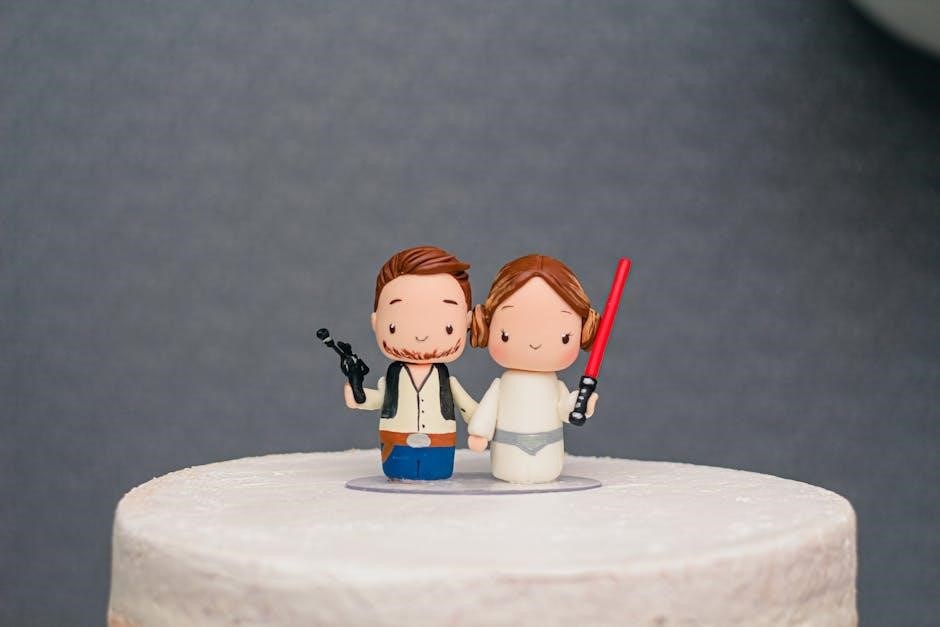
The Wilton Cake Serving Chart is a practical tool designed to help bakers determine the number of servings a cake can provide. Originating from Wilton Brands, a trusted name in baking since 1929, this chart simplifies cake planning for weddings and other events. It offers guidance on standard serving sizes, batter amounts, and pan preparation, ensuring consistent results. The chart differentiates between party and wedding servings, with wedding slices typically smaller (1×2 inches). It also provides tips for non-traditional shapes, like ovals or hexagons, ensuring uniform slices. By following the chart, bakers can estimate batter needs, fill pans correctly, and achieve professional-looking results. This resource is essential for anyone aiming to serve cakes fairly and efficiently, making it a cornerstone for wedding cake planning.
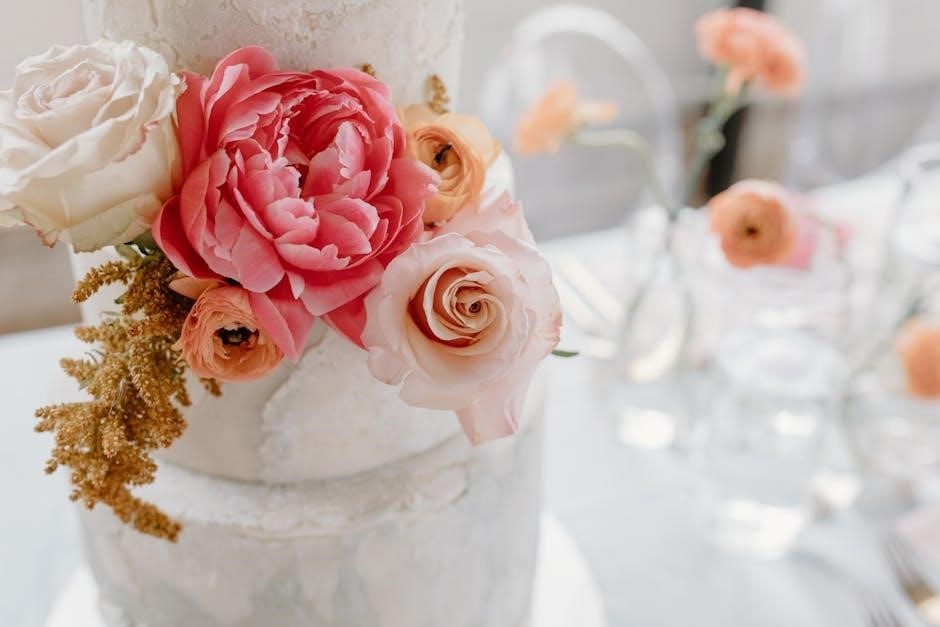
1.2 Importance of Proper Cake Serving at Weddings
Proper cake serving at weddings is crucial for ensuring a memorable and satisfying experience for all guests. It guarantees that each attendee receives an equitable portion, fostering fairness and delight. Wilton’s guide emphasizes that accurate serving sizes enhance the overall celebration, preventing under or over-serving. Correct portion control also aids in budget management, as it helps avoid wasting cake or running out. Additionally, proper serving etiquette and presentation contribute to the wedding’s aesthetic appeal, making the cake a central, Instagram-worthy element. By following the Wilton Wedding Cake Serving Guide, couples can ensure their cake is both delicious and beautifully presented, leaving a lasting impression on their special day. This attention to detail elevates the wedding experience, making it truly unforgettable for everyone involved.
Understanding the Wilton Cake Serving Chart
The Wilton Cake Serving Chart is a essential tool for determining the number of servings a cake can provide, helping bakers plan accurately for weddings and other events.
2.1 How to Read the Wilton Serving Chart
The Wilton Serving Chart is a valuable tool for determining how many servings a cake can provide. It is based on standard cake sizes and shapes, helping bakers plan accurately. To read the chart, start by identifying the cake size and shape, such as round or square. Next, locate the corresponding pan size and depth, as these factors affect the number of servings. The chart also provides guidelines for batter amounts, ensuring pans are filled correctly—typically 1/2 to 2/3 full for best results. For wedding servings, slices are smaller, around 1 x 2 inches, compared to party servings. Understanding the chart involves considering cake height, as taller cakes may yield the same servings as shorter ones due to consistent cutting patterns. By following the chart, bakers can ensure even portion distribution and avoid waste. It’s a straightforward guide to achieving perfect cake service at weddings and events.
2.2 Factors Affecting Serving Sizes
Several factors influence the serving sizes outlined in the Wilton Serving Chart. Cake shape, size, and height play significant roles, as round cakes yield different portions than square or rectangular ones. Taller cakes may require adjustments in cutting techniques to maintain uniform serving sizes. Pan depth is another critical factor; for example, 3-inch-deep pans should only be filled halfway to ensure even baking. Batter density and recipe type can also affect serving sizes, as denser cakes may result in larger portions compared to lighter ones. Additionally, the distinction between wedding and party servings matters, with wedding slices typically being smaller. Understanding these variables helps bakers accurately interpret the chart and plan their cakes accordingly, ensuring every guest receives a fair and delicious portion.
2.3 Standard Serving Sizes for Weddings
Standard serving sizes for weddings are designed to ensure consistency and fairness in portion distribution. According to the Wilton Serving Chart, wedding cake servings are typically based on slices measuring approximately 1 inch by 2 inches. This size is smaller than party servings, allowing more guests to be served from the same cake. The chart provides specific serving numbers for various cake sizes, such as 6-inch, 8-inch, and 10-inch tiers, helping bakers plan accurately. For example, a 6-inch tier usually serves 8-10 guests, while an 8-inch tier serves 12-15. These standards account for cake height and shape, ensuring uniformity. By adhering to these guidelines, bakers can create beautiful, evenly portioned wedding cakes that meet guest expectations. Proper pan preparation, such as filling pans 1/2 to 2/3 full, also supports achieving these standard serving sizes.
2.4 Differences Between Party and Wedding Servings
Party and wedding servings differ significantly in size and approach. Party servings are typically larger, with slices measuring about 1.5 inches by 2 inches, while wedding servings are smaller, around 1 inch by 2 inches. This smaller size allows for more servings from the same cake, catering to larger guest lists at weddings. The Wilton Serving Chart reflects this distinction, providing specific guidelines for both scenarios. Wedding servings are designed to be more formal and portion-controlled, ensuring consistency and fairness. In contrast, party servings are often more generous, focusing on convenience and larger portions. Understanding these differences is crucial for accurate planning and execution, whether for an intimate gathering or a grand celebration. The chart ensures bakers can adjust their strategies to meet the unique demands of each event type.
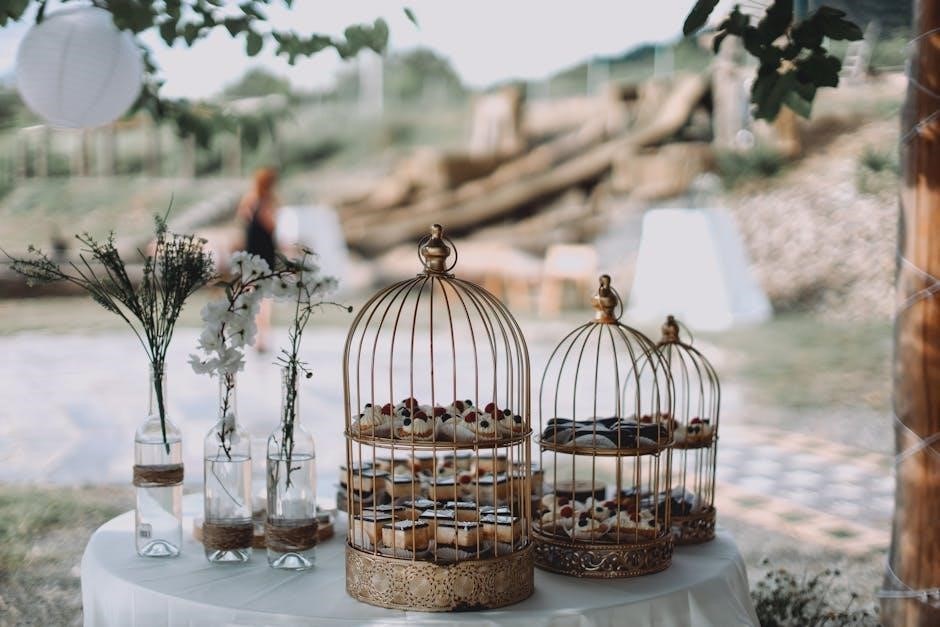
Planning Your Wedding Cake
Planning your wedding cake involves estimating guests, choosing size and shape, calculating tiers, and selecting pan sizes. This ensures your cake meets both aesthetic and serving needs, guided by the Wilton Wedding Cake Serving Guide.
3.1 Estimating Guest Count and Cake Needs
Accurately estimating the guest count is crucial for determining the right cake size. The Wilton Wedding Cake Serving Guide provides a detailed chart to help calculate servings based on cake dimensions. For weddings, slices are typically smaller (1×2 inches) compared to party portions, ensuring more servings from each tier. The chart specifies batter amounts for various pan sizes, helping bakers prepare adequately. For example, a 2-inch cake pan filled 2/3 with batter yields a specific number of servings. Understanding these details allows for precise planning, avoiding waste or shortage. Factors like cake height and shape also influence serving numbers, as taller cakes may require adjusting slice sizes. By using the guide, bakers can align cake needs with the wedding’s scale, ensuring every guest enjoys a fair portion. This step is foundational for a successful and stress-free wedding cake experience.
3.2 Choosing the Right Cake Size and Shape

Selecting the appropriate cake size and shape is essential for meeting guest demands and aesthetic preferences. The Wilton Wedding Cake Serving Guide offers insights into how different dimensions affect servings. Round cakes are traditional and easy to portion, while square or heart-shaped options may yield more servings due to their larger surface area. When choosing a size, consider the number of guests, serving sizes, and the cake’s height. Taller cakes can add visual impact without significantly increasing serving numbers. The guide provides charts to match cake dimensions with guest counts, ensuring the right fit for any wedding. Additionally, the shape should align with the wedding theme, whether classic or contemporary. By considering both size and shape, bakers can create a stunning centerpiece that satisfies both hunger and style, making the wedding cake a memorable highlight of the celebration.
3.3 Calculating the Number of Cake Tiers Needed
Determining the number of cake tiers required involves a combination of guest count, serving sizes, and design preferences. The Wilton Wedding Cake Serving Guide provides a structured approach to calculate tiers accurately. Start by estimating the total number of servings needed based on the guest list. Each tier size corresponds to a specific number of servings, which can be cross-referenced using Wilton’s charts. For example, a small tier might serve 20-30 guests, while larger tiers can accommodate 50 or more. The guide emphasizes considering both the visual impact and practicality, ensuring each tier complements the overall design without overwhelming the serving needs. Balancing aesthetics with functionality, the number of tiers should align with the wedding’s scale, whether it’s an intimate gathering or a grand celebration. This step ensures the cake is both visually stunning and adequately portioned for all attendees.
3;4 Selecting the Right Pan Sizes for Each Tier
Selecting the right pan sizes for each tier is crucial for achieving uniform baking and ensuring the cake tiers are proportional. The Wilton Wedding Cake Serving Guide recommends using pans that are appropriately sized for the number of servings needed. For example, a 10-inch pan typically serves 20-25 guests, while a 12-inch pan serves 30-35. The guide also suggests filling pans no more than 2/3 full to prevent overflow during baking. For deeper pans (3 inches or more), filling to 1/2 capacity is advised. Using the right pan size ensures even baking and avoids uneven tiers; Additionally, the guide provides batter amount guidelines for each pan size, helping bakers prepare the perfect quantity of batter. This step is essential for creating a structurally sound and visually appealing wedding cake. By following these guidelines, bakers can achieve consistent results and ensure every tier is perfectly baked.
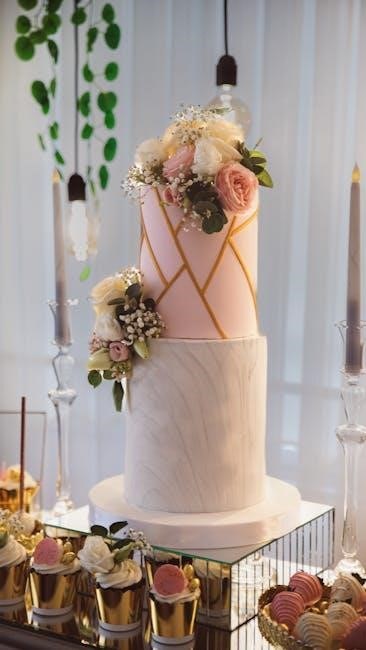
Baking Considerations
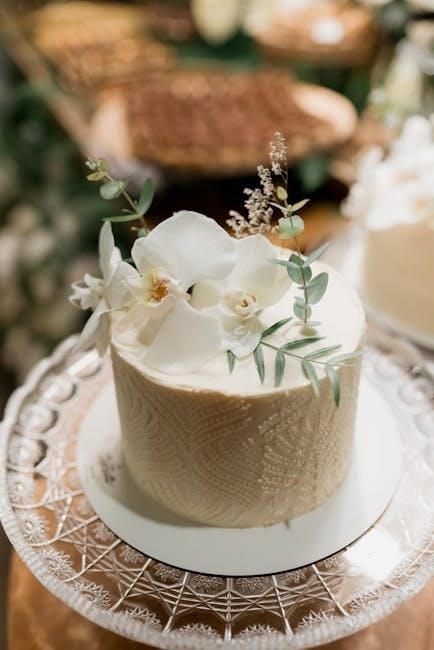
Proper batter distribution, pan preparation, and accurate baking times are essential for even baking. The Wilton Wedding Cake Serving Guide provides detailed tips to ensure consistent results and avoid common issues.
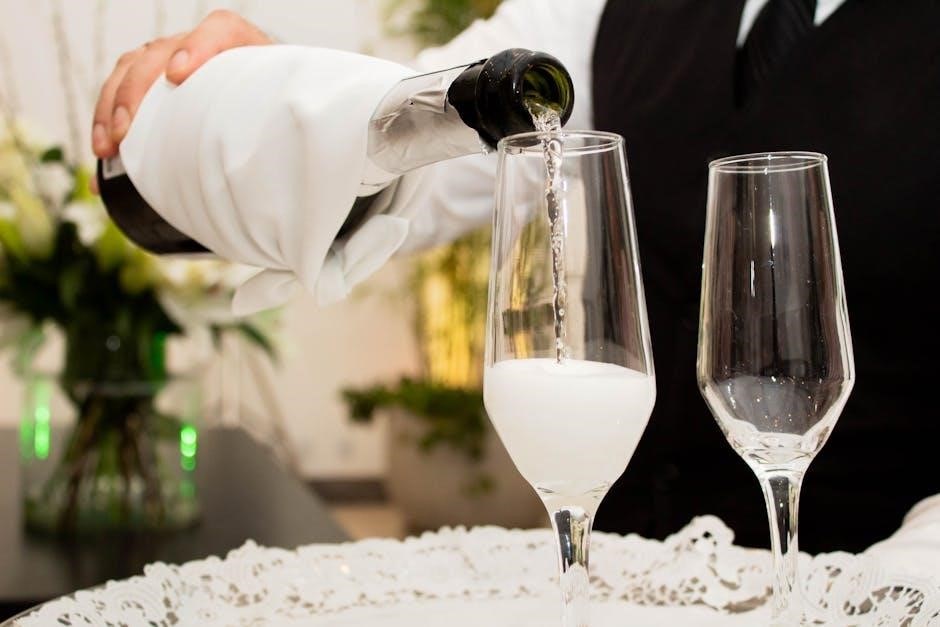
4.1 Batter Amounts for Different Cake Sizes
Accurate batter amounts are crucial for baking wedding cakes. For a 2-inch cake, approximately 1 1/4 cups of batter are needed, while a 6-inch cake requires about 4 cups. Larger cakes, such as 8-inch and 10-inch, need 6 cups and 8 cups, respectively. The Wilton Wedding Cake Serving Guide provides detailed measurements to ensure each tier is properly filled without overflow. Pans should be filled 1/2 to 2/3 full, with 3-inch deep pans filled only 1/2 full. This guide helps bakers estimate batter needs precisely, preventing waste and ensuring even baking. By following these guidelines, you can achieve consistent results for every cake size, from small tiers to large showpieces.
4.2 Pan Preparation Tips for Even Baking
Proper pan preparation is essential for achieving even baking results. Start by greasing your pans thoroughly with butter or cooking spray, ensuring complete coverage. For added security, line the bottom of each pan with parchment paper to prevent sticking and facilitate easy removal. When filling pans, avoid overfilling—fill them 1/2 to 2/3 full for optimal rise and to prevent overflow during baking. For larger cakes, consider using a heating core or rose nail in the center of the pan to ensure even heat distribution and prevent undercooked centers. Finally, allow cakes to cool in the pans for 5-10 minutes before transferring them to a wire rack to cool completely. These steps ensure a smooth, even bake, which is critical for the success of your wedding cake tiers.
4.3 Baking Times and Temperatures for Wedding Cakes
Accurate baking times and temperatures are crucial for perfect wedding cakes. Most wedding cakes bake at 325°F to 350°F, depending on size and depth. For smaller tiers (6-8 inches), bake for 20-30 minutes, while larger tiers (12-18 inches) may require 45-60 minutes. Check doneness by inserting a toothpick; it should come out clean. To ensure even baking, rotate pans halfway through the baking time. For deep pans (3+ inches), reduce the oven temperature by 10°F to prevent over-browning. Always refer to the Wilton chart for specific guidelines, as it provides detailed baking times based on cake size and pan depth. Proper temperature control ensures a moist, evenly baked cake, which is essential for a professional wedding cake presentation.
Cutting the Cake
Cutting the cake requires precision and care to ensure uniform slices. Use a serrated knife and stabilizing tools for clean cuts, especially for non-traditional shapes like ovals or hexagons. Wilton’s guide provides expert tips for achieving even portions and minimizing waste, ensuring every guest enjoys a perfectly sized slice of wedding cake.
5.1 Tools Needed for Cutting a Wedding Cake
Cutting a wedding cake efficiently requires the right tools. A long serrated knife is essential for making smooth, even cuts through multiple layers. Pair it with a sturdy cake stand or turntable to keep the cake stable during slicing. For serving, use a serving spatula to gently lift and transfer slices to plates without damaging the cake’s design. Additional tools like a cake leveler or adjustable guides can help ensure uniform portion sizes, especially for non-traditional shapes. For multi-tiered cakes, having a set of tools that can handle various sizes is crucial. Refer to Wilton’s expert recommendations for the best tools to achieve professional-looking results and maintain presentation quality during the special event.
5.2 Step-by-Step Guide to Cutting the Cake
Cutting a wedding cake requires precision to ensure even portions and a polished presentation. Start by placing the cake on a sturdy stand or turntable for stability. Begin with the bottom tier, slicing the cake into uniform wedges using a long serrated knife. For multi-tiered cakes, remove upper tiers before cutting to avoid damaging the lower layers. Cut each slice with smooth, steady strokes, aiming for consistent sizes. Use a serving spatula to carefully lift and transfer each portion to plates. For non-traditional shapes, such as ovals or hexagons, adjust your cutting pattern to maintain uniformity. Apply gentle pressure to avoid crumbling, and consider using stabilizing tools for intricate designs. Wilton’s guide recommends cutting slices approximately 1 inch wide and 2 inches long for wedding portions. This method ensures every guest receives an equal and beautifully presented slice.
5.3 Tips for Cutting Non-Traditional Cake Shapes
Cutting non-traditional cake shapes, such as ovals, hexagons, or hearts, requires careful technique to maintain uniformity and avoid waste. Use a serrated knife for clean cuts and a stabilizing tool to keep the cake steady. For oval cakes, start by cutting parallel slices from one end to the other, adjusting your angle slightly for even portions. Hexagonal cakes can be cut by dividing the shape into triangular sections, then slicing each triangle into smaller wedges. Heart-shaped cakes should be cut from the top point downward, creating equal-sized slices on both sides. Regardless of the shape, aim for slices measuring approximately 1 inch wide and 2 inches long. To prevent crumbling, apply gentle pressure and use a serving spatula to lift slices. Wilton’s guide recommends practicing on dummy cakes to master these techniques before the wedding day.
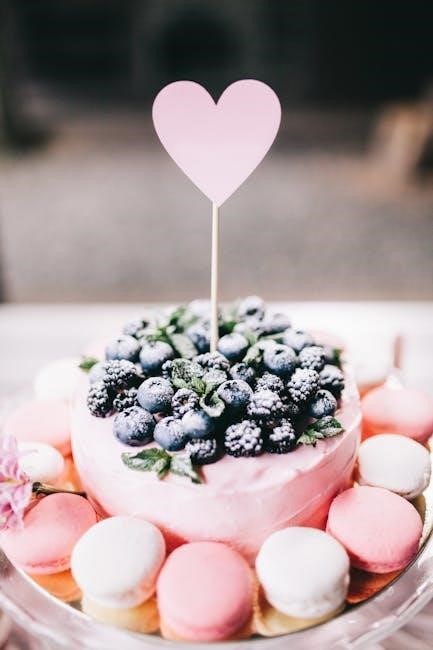
Serving Etiquette
Serving etiquette ensures a seamless and elegant cake service. Maintain portion control, present slices attractively, and time the serving to align with the wedding schedule for a polished experience.
6.1 Portion Control for Wedding Cake Servings
Portion control is essential for ensuring every guest receives a consistent and fair share of the wedding cake. According to the Wilton Wedding Cake Serving Guide, wedding cake servings are typically based on slices measuring about 1 inch by 2 inches. This standard size ensures uniformity and prevents waste. To maintain accuracy, use a serrated knife and stabilizing tools to cut clean, even slices. For non-traditional shapes, such as ovals or hexagons, the guide recommends cutting uniform slices by following specific patterns. Proper portion control not only enhances the guest experience but also preserves the aesthetic appeal of the cake. By adhering to these guidelines, you can ensure a polished and professional cake service at any wedding celebration.
6.2 Presentation Tips for Serving the Cake
Presentation plays a crucial role in the appeal of a wedding cake. To enhance the visual impact, ensure the cake is placed on a decorative stand or pedestal, making it a focal point of the reception. Use fresh flowers, greenery, or decorative toppers to match the wedding theme. Proper lighting is essential; soft backlighting or uplighting can highlight the cake’s details. When serving, arrange the slices neatly on a platter or individual plates, garnished with small decorations like berries or chocolate shavings. Consider the cake’s shape and design—non-traditional shapes like ovals or hexagons can be sliced uniformly for a polished look. Finally, ensure the cake is brought out ceremoniously, creating a memorable moment for guests. A well-presented cake not only delights the eyes but also reflects the thoughtfulness of the wedding planning.
6.3 Timing the Serving of the Cake
Timing is key when serving the wedding cake to ensure a seamless and enjoyable experience for all guests. Ideally, the cake should be served after the main course but before dancing or speeches begin. This allows guests to enjoy their dessert without feeling rushed. For larger weddings, consider slicing the cake during a lull in activities to avoid delays. The serving process should be well-coordinated with the venue staff and photographer to capture the cake-cutting ceremony. If the cake has multiple tiers, start with the bottom tier to maintain stability. Smaller cakes or non-traditional shapes may require earlier serving to accommodate guest numbers. Remember, the cake is a highlight of the event, so proper timing ensures it is memorable and stress-free for everyone involved.
Additional Tips and Resources
Wiltons blog and guides provide expert tips for perfect cake presentation and serving. Utilize their resources for creative ideas, portion control, and troubleshooting. Visit their website for detailed charts and step-by-step guides.
7.1 Do’s and Don’ts for Serving Wedding Cake
When serving wedding cake, do use a serrated knife for clean cuts and stabilize tiers with dowels to prevent shifting. Always fill pans 1/2 to 2/3 full for even baking. Don’t overfill pans, especially for deep cakes, as this can lead to uneven cooking. Ensure batter amounts align with cake size for consistent results. For non-traditional shapes, use stabilizing tools to avoid waste. Do refer to Wilton’s chart for accurate serving sizes and portion control. Don’t skip timing; serve the cake when it’s freshly cut to maintain texture. Follow these tips for a flawless wedding cake service.
7.2 Utilizing Wilton Resources for Guidance

Wilton offers comprehensive resources to guide bakers in creating and serving wedding cakes flawlessly. Their detailed charts and guides provide precise measurements for batter amounts, pan sizes, and serving portions. Wilton’s blog features expert tips and tutorials on topics like cutting non-traditional shapes and ensuring even baking. Utilize their pan preparation advice to avoid common baking mishaps. The Wilton Wedding Cake Serving Guide also includes visual aids, such as photos and diagrams, to help bakers understand complex techniques. By leveraging these resources, bakers can achieve professional results, ensuring every wedding cake is both visually stunning and delicious. Wilton’s tools are designed to simplify the process, making it easier to deliver a memorable dessert for any wedding celebration.
7.3 Real-Life Examples and Success Stories
Many bakers and couples have successfully used the Wilton Wedding Cake Serving Guide to create memorable wedding desserts. For instance, a baker used the guide to craft a stunning heart-shaped cake for a romantic wedding, ensuring precise portion control and beautiful presentation. Another couple relied on Wilton’s chart to plan a multi-tiered cake for 200 guests, achieving perfect serving sizes and rave reviews. The guide’s tips on cutting non-traditional shapes, like ovals or hexagons, have also inspired creative designs. One baker shared how Wilton’s pan preparation advice prevented cracks in a 4-inch tier, while another highlighted how the batter amount guidelines ensured consistency across all tiers. These success stories showcase how Wilton’s resources empower bakers to deliver professional, crowd-pleasing results. By following the guide, couples and bakers alike can create wedding cakes that impress both in taste and presentation.
